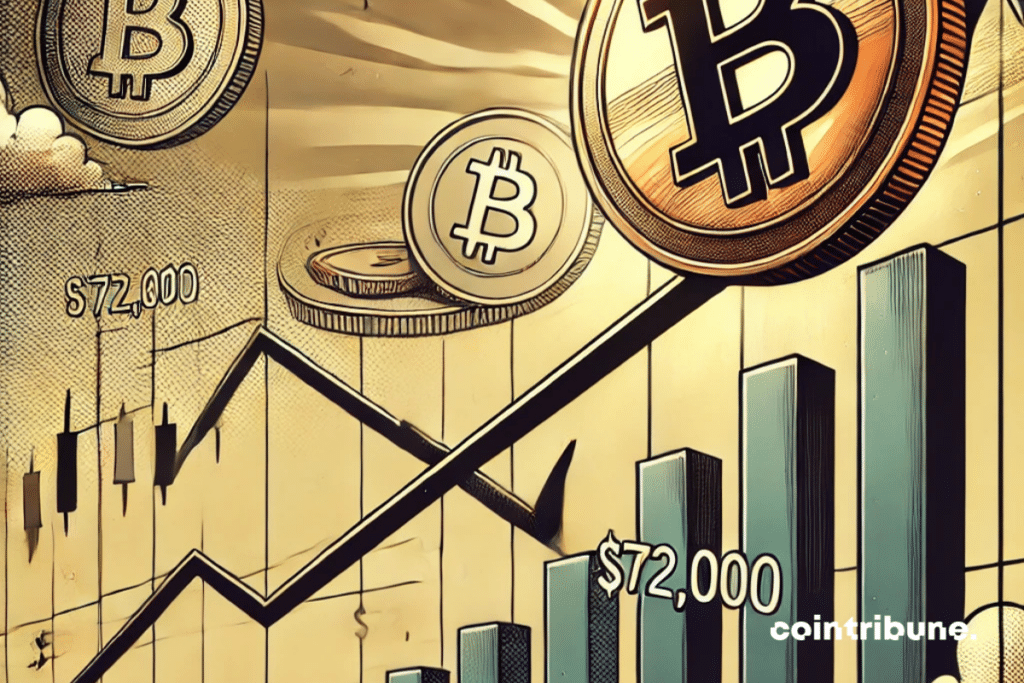While Bitcoin appeared to be headed for $75,000, the latest economic data from the US abruptly halted that rally. In the face of unchanged personal consumption expenditure (PCE) inflation and strong core inflation, hopes of monetary easing by the Federal Reserve are dwindling, throwing investors into doubt. This tense macroeconomic context, together with the cautious reactions of institutional players, amplifies pressure on long positions and amplifies price volatility.

Bitcoin falls in the face of US economic data
While Bitcoin stagnated around $72,000 on October 31, 2024, the latest US Personal Consumption Expenditure (PCE) data failed to revive the market. In fact, this data leaves him in the download dynamic. The September report showed that inflation in personal consumption expenditures, the Fed’s preferred gauge for tracking inflation, fell to 2.1%, in line with expectations. In contrast, Core PCE inflation was unchanged at 2.7%, slightly above forecasts of 2.6%.
It should be noted that it has now been six months since core inflation stopped falling, casting doubt on the effectiveness of the Fed’s tightening policy. Such a situation prompted business source The Kobeissi Letter to respond. “The Fed’s rate cut is on hold again,” he said on X. So the market was hoping for a hint of Fed policy easing, but this expectation was dashed by still high indicators. The PCE rate, closely watched by investors for its implications for Fed decisions, only reinforced the idea of tight monetary policy in the immediate future.
At the same time, the odds of a rate hike hold at the Fed’s Nov. 7 meeting have consolidated to 96%, leaving little room for adjustments favorable to risk assets such as bitcoin. This context has put the crypto market into a wait-and-see mode with increasing pressure on long positions. For investors, it’s the November 1 US employment report that could bring another wave of volatility for BTC, reminding us that macroeconomic risks still have control over the asset’s trajectory.
Market Participant Reaction and Implications for Bitcoin
Faced with this discouraging economic situation, whales and other institutional investors quickly adjusted their positions. Market order data shows significant reductions in exposure among large BTC holders, indicating heightened caution in the face of economic uncertainties. More than $500 million in open interest has already disappeared with just a 2% drop in price. This reduction in open interest coupled with whale behavior reflects a loss of confidence in Bitcoin’s ability to sustainably break above $70,000 in this context.
With the month closing, Bitcoin is nearing its key resistance level with a gain of over 13% for the month of October. However, volatility looks set to intensify in the coming days, making it difficult to predict price action. The Fed’s influence, combined with the cautious behavior of the major players, hardly suggests an immediate increase.
In short, macroeconomic pressure and the increased caution of influential players create fertile ground for increasing volatility. Future events, especially economic publications and Fed decisions, will be crucial in assessing whether Bitcoin can actually reach or even sustainably maintain the $70,000 mark.
Maximize your Cointribune experience with our “Read and Earn” program! Earn points for every article you read and get access to exclusive rewards. Register now and start reaping the benefits.
A graduate of Sciences Po Toulouse and holder of the blockchain consultant certification issued by Alyra, I joined the Cointribune adventure in 2019. Convinced of the potential of blockchain to transform many sectors of the economy, I made a commitment to raise awareness and inform the general public about this ever-evolving ecosystem. My goal is to enable everyone to better understand blockchain and take advantage of the opportunities it offers. Every day I try to provide an objective analysis of current events, decipher market trends, convey the latest technological innovations and put into perspective the economic and social problems of this ongoing revolution.
DISCLAIMER OF LIABILITY
The comments and opinions expressed in this article are solely those of the author and should not be considered investment advice. Before making any investment decision, do your own research.